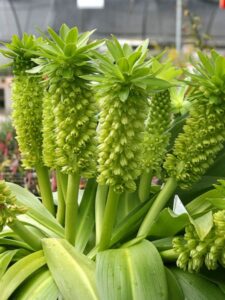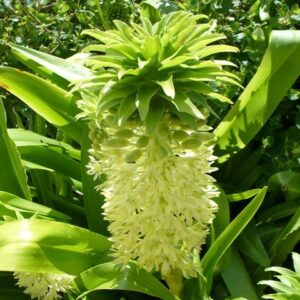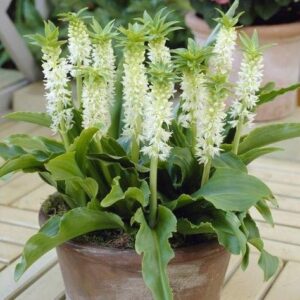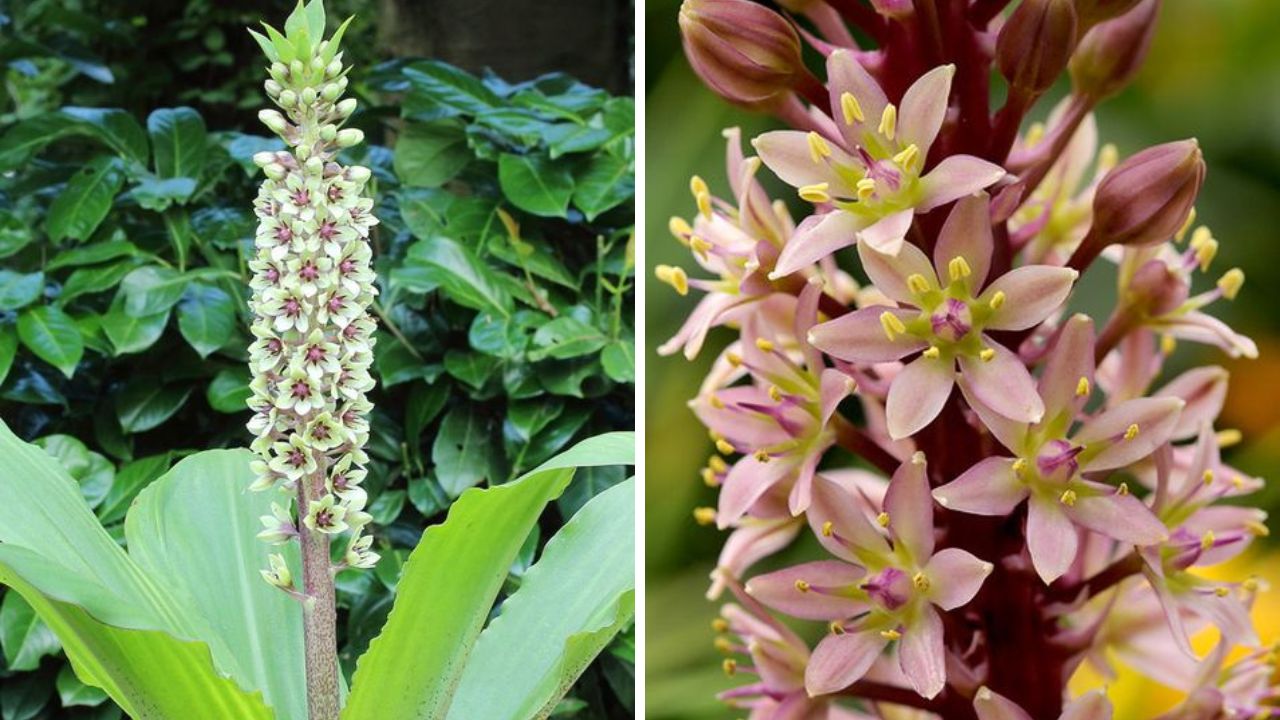Although it is a flower bulb, the pineapple lily is neither a real lily nor a pineapple. The flower stalks of pineapple lily plants produce tiny, star-shaped blooms that open in a cylindrical raceme from the bottom up and then grow into a small crown of leafy bracts that resembles a cap’s feathers. This pineapple-shaped plant needs full sun to light shade, coarse, well-draining soil, and temperatures that regularly remain above 65 degrees Fahrenheit. It grows best in warmer, fairly humid climates.
Pineapple Lily Plant Overview

| Common Name | Pineapple lily, pineapple flower |
| Botanical Name | Eucomis spp. |
| Family | Asparagaceae |
| Plant Type | Perennial, annual, bulb |
| Mature Size | 18-36 in. tall, 18-24 in. wide |
| Sun Exposure | Full, partial |
| Soil Type | Loamy, well-drained |
| Soil pH | Acidic, neutral, alkaline |
| Bloom Time | Summer |
| Flower Color | Green, purple, pink, white |
| Hardiness Zones | 7-10 (USDA) |
| Native Area | Africa |
Pineapple Lily Care

The primary care needs for pineapple lilies are listed below:
- Because they are indigenous to South Africa’s harsh soils, pineapple lilies require full sun and excellent drainage.
- Start with huge bulbs; they will provide several flower stalks on unique stems splashed with burgundy.
- To assist bulbs survive the winter in hardy regions, plant in the spring and bury the bulbs at least five inches below the surface.
- Throughout the winter, store bulbs somewhere cold, dark, and extremely dry.
Light Requirements
Full sun is ideal for pineapple lilies to grow and bloom. In southern gardens, a little midday shade might help keep leaves from browning from the intense sun.
Soil and Potting
Pineapple lilies thrive in rocky soil and are not tropical plants, despite their lush look. As long as the potting mix mixture you choose for your plants drains properly, it works well in pots for cacti or orchids.
Watering
When the soil seems dry, water your pineapple lilies. But, as it’s crucial to keep the bulbs dry during the winter, cease watering them in the fall.
Temperature and Environment
Cool weather stunts the growth of pineapple flowers. When the temperature rises above 65 degrees Fahrenheit, plants will know it’s time to start growing. If you live north of zone 7, dig out your bulbs in the fall and store them inside. All humidity levels are OK to the plants as long as the soil isn’t too wet.
Fertilization
Every two weeks, apply a balanced flower fertilizer to your pineapple lilies to encourage their enormous, robust growth. Fertilized plants also have a higher chance of producing offsets. Refer to the product label for directions on how much to use.
Types of Pineapple Lily

Among the common species, cultivars, and hybrids of pineapple lilies are:
- Eucomis comosa ‘Joy’s Purple’ has deep purple flowers as well as purple foliage.
- Eucomis comosa ‘Cornwood’ bears late-season creamy flowers with maroon centers.
- Eucomis autumnalis (Autumn pineapple flower) blooms from midsummer to mid fall.
- Aloha Lily is a hybrid dwarf series including ‘Lieia’ with burgundy flowers, ‘Maui’ with white flowers, and ‘Nani’ with soft pink flowers.
Pruning
When pineapple lilies are actively growing, they don’t require any pruning. Even in warm climates, all plants will go into winter dormancy. Now is the time to tidy up the plants by removing any dead or dying foliage.
Propagating Pineapple Lily
When flowering is over, you can harvest the glossy black seeds from pineapple lilies, although this approach is not advised for a number of reasons. Cultivar seeds can take several years to mature into blooming plants; they will not yield plants exactly like the parent. The simplest method to grow more pineapple lilies in your collection is to harvest offsets from the bulbs: In the spring, dig up the bulbs, trim off the offsets, and plant them at the same depth as the parent. Plant the original bulb again.
Leaf cuttings are another method of propagating pineapple lilies. Here’s the procedure:
- If it doesn’t rain in the middle of summer, give the plant plenty of water the day before you take a cutting. Cut off a large, healthy leaf with a sharp knife or a fresh, sterilized razor blade.
- To make the leaf simpler to place into the growth media, cut it into 2- to 3-inch-long portions, and trim the bottom of each cutting into a V shape.
- Soak each cut end completely in rooting hormone at the base of the cutting.
- Place the cuttings in a big, level container with plenty of holes for drainage. Potting mix that has been moistened should be added to the pot. The cutting must be buried all the way to the cut side.
- The pot should be placed in a well-lit area, but not in direct sunlight.
- Always keep it damp but not drenched.
- New roots have grown when you gently tug on the cuttings and they become difficult to move. Before replanting the cuttings in the garden, give them a few more weeks in the container until new growth appears.
Potting and Repotting
Potted pineapple lilies only need to be planted three inches below the surface, far less deeply than its ground-based counterparts. Put three or five bulbs in a pot with a 12-inch diameter. Select potting mix that is chunky or gritty and a container with enough drainage holes. Instead of setting a dish underneath the pot to catch water, use pot feet to allow the water to drain out. If the pot is being kept outside, keep it out of the rain to ensure that the soil in moist climates is well-drained.
Overwintering
For plants to survive the winter dormant period, bulbs must be kept dry. Dig up the bulbs and put them indoors to achieve the essential dry dormancy if your winters are moderate but wet.
Common Pests
The pineapple lily is resistant to all major illnesses and pests.1. Aphids are the sole serious hazard to this plant, and they can cause problems for both indoor and outdoor plants. Use a strong stream of water to naturally remove them.
How to Get Pineapple Lily to Bloom?
How Long Does Pineapple Lily Bloom?
In the summer, the pineapple lily blooms for eight weeks straight, beginning in May or June. Starting at the base of the stem, the blossoming moves upward.
What Do Pineapple Lily Flowers Look and Smell Like?
The little, beautiful purple-tinged greenish-white blossoms are tiny. With one exception—the petals have a fairly pleasant smell to some, but their distinct scent is meant to draw pollinating flies—these long-lasting blooms make good cut flowers.
How to Encourage More Blooms?
One possible reason why your plant isn’t blossoming is a lack of sunlight. Your new pineapple lily might not bloom right away because it takes a few years for the plant to mature after being propagated from cuttings.
Caring for Pineapple Lily After It Blooms
After flowering, pineapple lilies don’t need much maintenance. If the spent flower heads appear untidy, trim them. In the fall, remove any dead leaves. To store bulbs for the winter, remove and let them dry.
Common Problems With Pineapple Lily
This plant can still have a few issues even though it is resilient and requires little care. Keep an eye out for these problems:
Drooping, Wilting Leaves
Wet the plant too much. Yellowing leaves are a more advanced indicator of overwatering a pineapple lily. When overwatering occurs, the base of the plant may also start to turn black.
Scorched Leaves
The flower is being overexposed to the sun, burning from the extreme heat and light.
Also Read: Eastern Prickly Pear Cactus Complete Guide To Grow And Care

Pingback: African Spear Plant Complete Guide To Grow And Care